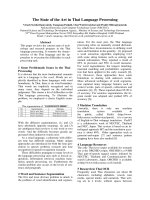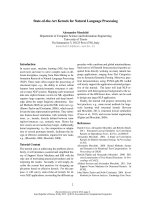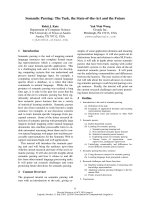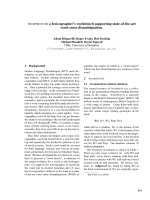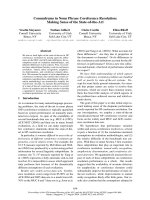Mobile Robots - State of the Art in Land, Sea, Air, and Collaborative Missions docx
Bạn đang xem bản rút gọn của tài liệu. Xem và tải ngay bản đầy đủ của tài liệu tại đây (31.39 MB, 346 trang )
Mobile Robots - State of the Art
in Land, Sea, Air,
and Collaborative Missions
XiaoQi Chen, Y.Q. Chen and J.G. Chase
Mobile Robots - State of the Art
in Land, Sea, Air,
and Collaborative Missions
Edited by
In-Tech
intechweb.org
XiaoQi Chen, Y.Q. Chen and J.G. Chase
V
Preface
Since the introduction of the first industrial robot UNIMATE in a General Motors automo-
bile factory in New Jersey in 1961, robots have gained stronger and stronger foothold in the
industry. In the meantime, robotics research has been expanding from fix based robots to
mobile robots at a stunning pace. There have been significant milestones that are worth not-
ing in recent decades. Examples are the octopus-like Tentacle Arm developed by Marvin
Minsky in 1968, the Stanford Cart crossing a chair-filled room without human assistance in
1979, and most recently, humanoid robots developed by Honda.
Despite rapid technological developments and extensive research efforts in mobility, per-
ception, navigation and control, mobile robots still fare badly in comparison with human ab-
ilities. For example, in physical interactions with subjects and objects in an operational envi-
ronment, a human being can easily relies on his/her intuitively force-based servoing to
accomplish contact tasks, handling and processing materials and interacting with people
safely and precisely. The intuitiveness, learning ability and contextual knowledge, which are
natural part of human instincts, are hard to come by for robots.
Hardware technologies including materials, novel actuator and mechanisms, and drives
have been a severe limiting factor in mobile robots emulating human beings. The well-
known Honda humanoid robot Asimo has a self weight of 52 Kg, and a lifting capacity of 1
Kg with two hands. In the 2008 Olympics held in Beijing, the women 53 Kg weightlifting
gold medal went to a Thai girl who lifted 126 Kg in Clean and Jerk. Her lifting capacity to
self weight ratio is about 2.4 while Asimo has the ratio of about 0.02. The ratio for a non-
athletic adult would be about 0.4, much lower than an Olympic champion, but a magnitude
higher than Asimo.
The above observations simply highlight the monumental works and challenges ahead
when researchers aspire to turn mobile robots to greater benefits to humankinds. This book
is by no means to address all the issues associated mobile robots, but reports current states
of some challenging research projects in mobile robotics ranging from land, humanoid, un-
derwater, aerial robots, to rehabilitation.
Chapter 1 provides an overview on mobile robotics. It proposes a functional model of gene-
ralized robots by drawing the parallelism between robots and humans. It also points to ser-
vice robots being a disruptive technology in decades to come.
VI
Chapter 2 introduces a field robot using the rotated-claw wheel that has strong capacity of
climbing obstacles. The rotated-claw wheel overcomes the disadvantages of conventional
mobile robot wheels, and provides a better solution for field and planetary robots.
Chapter 3 presents a mobile wheeled robot with step climbing capabilities using parallel in-
dividual axels. The wheel sets are designed to revolve in any direction independent of the
rotation of the wheels, satisfying the primary requirements for the robot traversing rough
terrains and climbing stairs.
Chapter 4 reviews some major efforts made over the past 20 years in the field of cable-
climbing mechanism design to provide a basis for future developments in this field. One
application highlighted is power line inspection in the power industry.
Chapter 5 proposes a multi-sensing fusion system to mimic the powerful sensing and navi-
gation abilities of a cockroach. The paper proposes a multi-sensor fusion system, and a dis-
tributed multi-CAN bus-mastering system based on Field Programmable Gate Array
(FPGA) and Advanced RISC Machine (ARM) microprocessor.
Chapter 6 highlights some characteristics observed from human abilities in performing both
knowledge-centric activities and skill-centric activities. The observations can be utilised to
guide the design of a humanoid robot’s body, brain and mind.
Chapter 7 reports an Autonomous Underwater Vehicle (AUV) prototype that had been de-
veloped recently at the University of Canterbury. The AUV has been specially designed for
shallow water tasks, such as inspecting and cleaning sea chests of ships.
Chapter 8 establishes an approach to solve the full 3D Simultaneous Localisation and Map-
ping (SLAM) problem, applied to an underwater environment. A new measurement system
has been designed for large area’s globally-consistent SLAM: buoys for long-range estima-
tion, and camera for short-range estimation and map building.
Chapter 9 addresses flight dynamics modelling and method of model validation using an
on-board instrumentation system. The validation process involves in-flight measurement of
all parameters as well as wind speed detected by in-house built air-speed sensor, aiming for
an accurate flight simulation system for auto-pilot development and preliminary design of
Unmanned Aerial Vehicles (UAVs).
Chapter 10 describes a numerical procedure for optimal sensor-motion scheduling of diffu-
sion systems for parameter estimation. The work introduces the optimal actuation frame-
work for parameter identification in distributed parameter systems. This contribution lays a
rigorous foundation for real-time estimation for a class of cyber-physical systems.
Chapter 11 presents some heuristics for constructing the mobile collector collection route.
Control schemes for coordinating multiple collectors are designed efficiently to maximize
the performance.
Chapter 12 discusses the development of the augmented reality (AR) for human-robot col-
laboration (HRC) system from concept and background through the design of the necessary
set of interfaces required to enhance human-robot interaction. The AR-HRC system gives
the user the feeling of working in a collaborative human-robot team rather than the feeling
of the robot being a tool, as a typical teleoperation interface provides.
, and J.G. ChaseX.Q. Chen
1
, Y.Q. Chen , Editors
2 1
1
Department of Mechanical Engineering
University of Canterbury, New Zealand
2
Center for Self-Organizing and Intelligent Systems (CSOIS)
Utah State University, USA
VII
Chapter 13 details a set of classifications of indoor localization techniques. The classifica-
tions presented provide a compact form of overview on WSN-based indoor localizations.
The chapter further introduces server-based and range-based localization systems that can
be used for the indoor service robot.
Chapter 14 proposes a wearable soft parallel robot for ankle joint rehabilitation after care-
fully studying the complexities of human ankle joint and its motions. The proposed device is
an improvement over existing robot in terms of simplicity, rigidity and payload perform-
ance.
The collection of the above research works is suitable for robotics researchers, engineers and
academics. It can be used as case studies in advanced robotics courses. Some chapters serve
as tutorial references in nature, while other chapters allow methods and results to be readily
reproducible.
The editor is indebted to all authors for being forthcoming in sharing their knowledge and
research work in such an open access platform. Their valuable contributions to this book are
gratefully acknowledged. Special thanks to Aleksandar Lazinica the
Edi
tor-in-Chief of IN-
TECH for his support in publishing this book, his passion and enthusiasm in bringing scien-
tific knowledge to a larger public.
IX
Contents
Preface V
Mobile Robots - State of the Art in Land, Sea, Air, and Collaborative
Missions
1. Mobiles Robots
–
Past Present and Future 001
X.Q. Chen, Y.Q. Chen, and J.G. Chas
e
2. A Field Robot with Rotated-claw Wheels
033
Yue, Jizhong Xiao, Kai Li, Jun Du, Shaoping Wang
3. Mobile Wheeled Robot with Step Climbing Capabilities 049
Gary Boucher, Luz Maria Sanche
z
4. Cable-Climbing Robots for Power Transmission Lines Inspection 063
Mostafa Nayyerloo, XiaoQi Chen, Wenhui Wang, and J Geoffrey Chas
e
5. Bionic Limb Mechanism and Multi-Sensing Control for Cockroach Robots 085
Weihai Chen, XiaoQi Chen, Jingmeng Liu, Jianbin Zhang
6. Biologically-Inspired Design of Humanoids 105
Xie M., Xian L. B., Wang L. and Li J.
7. The State-of-Art of Underwater Vehicles – Theories and Applications 129
W.H. Wang, R.C. Engelaar, X.Q. Chen & J.G. Chas
e
8. General Concept of 3D SLAM 153
Peter Zhang, Evangelous Millos & Jason Gu
9. Flight Dynamics Modelling and Experimental Validation for Unmanned Aerial
Vehicles
177
X.Q. Chen, Q. Ou, D. R. Wong, Y. J. Li, M. Sinclair, A. Marburg
10. Optimal Real-Time Estimation Strategies for a Class of Cyber-Physical Systems
Using Networked Mobile Sensors and Actuators
203
Christophe Tricaud & YangQuan Chen
X
11. Effective Heuristics for Route Construction of Mobile Data Collectors 223
Samer Hanoun & Saeid Nahavandi
12. An Augmented Reality Human-Robot Collaboration System 245
Scott A. Green, J. Geoffrey Chase, XiaoQi Chen and Mark Billinghurst
ȱ
13. Indoor Localization Techniques based on Wireless Sensor Networks
277
Hyo
-
Sung Ahn and Wonpil Yu
ȱ
14. Multi-criteria Optimal Design of Cable Driven Ankle Rehabilitation Robot
303
P. K. Jamwal, S. Q. Xie, K. C. Aw and Y. H. Tsoi
ȱ
1
Mobiles Robots – Past Present and Future
X.Q. Chen
1
, Y.Q. Chen
2
, and J.G. Chase
1
1
Department of Mechanical Engineering
University of Canterbury, New Zealand
2
Center for Self-Organizing and Intelligent Systems (CSOIS)
Utah State University, USA
1. Introduction
Since their introduction in factories in 1961, robots have evolved to achieve more and more
elaborate tasks. The industrial robots now account for a 5 billion dollars market. Positioned
along the assembly line, a robotic manipulator can perform tedious and repetitive tasks such
as welding, painting, moving or cutting with immense speed and incredible accuracy. As an
example, their use in the automotive industry has drastically cut the time it takes to
assemble a vehicle.
Since the introduction of the first industrial robot UNIMATE online in a General Motors
automobile factory in New Jersey in 1961, robots have gained stronger and stronger
foothold in the industry. Several milestones are worth noting since then:
The first artificial robotic arm to be controlled by a computer was designed. The Rancho
Arm was designed as a tool for the handicapped and its six joints gave it the flexibility of a
human arm.
DENDRAL was the first expert system or program designed to execute the accumulated
knowledge of subject experts.
1968 - The octopus-like Tentacle Arm was developed by Marvin Minsky.
1969 - The Stanford Arm was the first electrically powered, computer-controlled robot arm.
1970 - Shakey was introduced as the first mobile robot controlled by artificial intelligence. It
was produced by SRI International.
1974 - A robotic arm (the Silver Arm) that performed small-parts assembly using feedback
from touch and pressure sensors was designed.
1979 - The Stanford Cart crossed a chair-filled room without human assistance. The cart had
a TV camera mounted on a rail which took pictures from multiple angles and relayed them
to a computer. The computer analyzed the distance between the cart and the obstacles.
It is no surprising that in face of diverse configurations, functions, applications, and
autonomy there is no agreeable universal definition of “Robot”. The well-known definition
of Robot from the Robot Institute of America (RIA) is that a robot is
"A reprogrammable, multifunctional manipulator designed to move material, parts, tools, or
specialized devices through various programmed motions for the performance of a variety
of tasks".
Mobile Robots - State of the Art in Land, Sea, Air, and Collaborative Missions2
It at best describes industrial robots and applications – not all robotic applications are
associated with “move things”. “Programmed motions” may have to be augmented for
mobile robots that often decide their motion/part based on their situational awareness. A
more inspiring and general definition can be found in Webster. According to Webster a
robot is:
"An automatic device that performs functions normally ascribed to humans or a machine in
the form of a human."
The Webster definition broadly covers robotic tasks and functions beyond moving things as
in RIA definition. Being a subset of robots, one may consider that defining mobile robot
would be easier and more accurate. Indeed, Wikipedia has this definition:
“A Mobile Robot is an automatic machine that is capable of movement in a given
environment.”
As opposed to fix based industrial robots, a mobile robot has its movement unlimited by its
physical size due to its mobility. As a result, mobile robots can operate in a large workspace
and explore unknown environments and therefore are able to perform tasks wherever
needed. They have been used to perform a variety functions that are normally performed by
humans or a machine in the form of a human, such as surveillance, exploration, patrol,
homeland security, domestics helper (e.g. lawn mower), butler, care taker, and entertainer.
The recent decade has witnessed an explosion of research activities in mobile robotics. By
and large, mobile robots can be categorized into three categories according to their
operating environments: i) land (based) robots, ii) aquatic/underwater robots, and iii) aerial
(air, flying) robots; each of them possessing sub-categories
Because of the need to operate in unknown and/or uncertain environments, mobile robots
demand much higher level intelligence than traditional industrial robots. These
requirements have been met by the phenomenal advancement in silicon technology and
computing power. The rapid reduction in both size and cost of integrated chips has raised a
huge interest for scientists to create intelligent systems.
This chapter provides an overview on mobile robotics. Instead of attempting to cover the
wide area of this subject exhaustively, it highlights some key developments. Firstly, a
functional model of generalized robots is presented, and serves as a common conduit which
helps the analysis and comparison of robotics technology. It then paints a global perspective
of mobile robotics market, followed by historical development highlighted by some key
milestones. Subsequently, the chapter presents the state-of-the-art in mobile robotics
research, and summarizes the works presented in this book. Some critical reflections and
challenges ahead are highlighted as far as future development is concerned. Finally
conclusions are drawn.
2. Functional model of generalized robots
A generalised robot or robotic system possesses a set of functional parts similar to human
beings. As shown in Fig. 1, these functional parts include intellectual, statue, motivational,
actuation, sensory, communications and energy.
Mobiles Robots – Past Present and Future 3
Intellectual (information
processing and decision making)
Actuation
Motivational SensoryStatue
Communication
Energy
Environment (workspace, natural, other subjects)
Mobility
Intellectual (information
processing and decision making)
Actuation
Motivational SensoryStatue
Communication
Energy
Environment (workspace, natural, other subjects)
Mobility
Fig. 1. Functional model of generalised robots
The functional model in Fig. 1 clearly illustrates the energy forward path and information
feedback path. The intellectual part commands the actuation part, which in turn drives the
mobility system - statue and motivational parts. Mobility is achieved through statue and
motivational parts driven by actuators. Statue refers to body frame (skeleton) in case of a
human being, and mechanical frame for a robot. In industrial robots, the mechanical frame
is the mechanical links linked through joints. In mobile robots, the mechanical frame is the
airframe for aerial robots, hull structure for underwater vehicle, and chassis for land vehicle,
mechanical structure for humanoid robot.
Motivational parts are accessory mechanical parts to robots and limbs to human beings.
They either enlarge or refine the robot mobility to execute specific tasks. Wheels, tracks,
propellers increase the range of robot movement well beyond its statue. Grippers and end-
effectors enhance the dexterity of the workspace and manipulation. Like a human, a robot
accomplishes a delicate task like assembly, welding, and polishing by being equipped with
motivational parts.
In accomplishing a defined mission, a robot, through its statue and motivational blocks,
physically interacts with its operating environment. Robot operating environments can be
classified into the following three categories:
Pre-defined and structured environment. The robot has all the knowledge about the
environment and objects to deal with. It typically exists in factory automation
Semi structured environment. The robot has some pre-knowledge (e.g. GPS maps) about the
environment, but it may change spatially and temporally. An example would be
surveillance robot which tours its familiar territory, but the environment and objects inside
it may change spatially and temporally.
Unstructured environment. The robot has no priori knowledge about it, with underwater
being an example. The robot has to rely on its powerful sensory and navigation system to
operate autonomously. A practical approach would be semi-autonomous system which
accepts remote intervention from time to time.
In the energy forward path, a robot exerts energy onto the environment. In this process, the
primary energy source (typically electrical) is converted to other types of energy such as
Mobile Robots - State of the Art in Land, Sea, Air, and Collaborative Missions4
kinetic, mechanical, wave, etc while a task is performed by the robot. In this process, the
robot communicates with the environment through data, image, video or sound. It receives
situational information through its Sensory functional block, which closes the control loop.
Although both robots and human beings possess the same set of functional blocks, hence
have correspondence in each block. A parallel drawn between robots and human being in
terms of realisation of these functions is shown in Table 1. It is apparent that for a robot to
perform similar tasks like a human being, it indeed needs to possess the seven essential
functional parts. Nevertheless, for simple applications in a more deterministic operating
environment some of the functions such as sensory function are reduced to minimal.
Functional Blocks Human Beings Robots
Intellectual Brain Microprocessor
(computer hardware and software)
Statue Skeleton Mechanical frame (airframe, chassis,
hull).
Motivational Limbs Wheels, legs, tracks, propellers,
grippers, etc.
Actuation Muscles Hydraulic, electric, pneumatic.
piezoelectric, electrostatic actuators;
artificial muscles.
Sensory (perception) Eyes, ears, skin Cameras, optic sensors, sonar, sound,
infra-red light, magnetic fields,
radiation, etc.
Communication Speech, gesture Data, image/video, sound
Energy Food / energy storage Power source / energy storage.
Table 1. Robots versus human beings: functional blocks
As a result, a mobile robot is a complex assembly of fundamental building blocks, each of
which has to be carefully chosen based on specifications such as terrain, mission duration,
goal and atmospheric conditions. The “optimal” design aims for the robot to accomplish a
specific mission most cost effectively and efficiently. In contrast, a human being always uses
the same set of “functional bocks” to accomplish any type of missions - marathon, sprinting,
assembly, inspection and entertainment.
The mobility system accomplishes certain tasks by interacting with its operating
environment, known or unknown. It is therefore important to take the various functions into
consideration when design a mobile robot.
Mobility: Mobility in mobile robots requires mechanical frame and motivational parts.
Another consideration is to give the mobile robot locomotion capabilities based on its
deployment environment and missions. If the robot will only encounter smooth ground,
wheels or tracks would be reasonable. Rougher terrain would require bigger wheels. In
search and rescue mission in debris, leg locomotion is desired.
Sensors: A large collection of sensors are available to detect information about the
environment. They can be used for monitoring purposes (chemical sensors, thermometers)
or to help the robot to maintain its operations (accelerometers, GPS, etc…).
Actuators: They allow the robots to perform extra tasks besides mobility.
Mobiles Robots – Past Present and Future 5
On-board Computation: Depending on its purpose a mobile robot will require more or less
advanced on-board computation. Simple robots will just need steering computation
capabilities whereas robots interacting with humans will require advanced electronics to
successfully communicate.
Software: The software includes all the processes required by the robot to operate. They
range from low level mobility processes up to behavioural processes.
Energy: Mobile robots usually operate in remote environments where energy is not readily
available. Carrying the necessary energy to finish the assigned task is a necessary condition
when creating a mobile robot.
Communication: In many applications, communication is essential to a mobile robot. It can
be used to monitor the robot, to communicate with other robots or to communicate
information.
3. Global perspective of mobile robotics market
They are several identified markets for mobile robots: service and military robots.
3.1 Service
Service robots are usually divided into 2 sub-categories: Professional and Domestic robots.
The first one includes robots designed to serve either humans or equipment. As an example,
medical robots can be used to assist for surgeries as well as help for the training of surgeons.
Robotically-assisted surgery systems markets are supposed to have rapid growth. The
market that was at $626.5 million in 2007 is anticipated to reach $1 billion in 2008 and is
forecast to reach $14 billion by 2014. Mobile robots are also developed to work as tour
guides (Toyota’s “Robina” or Fujitsu’s “Enon”).
Fig. 2. Robina, Toyota’s tour guide (left) and Fujitsu’s Enon (right)
Service robots are also developing for equipment service such as pipe and window cleaning.
They are designed to perform tasks such as inspection, maintenance and repairs.
The latter category of service robots is known as personal robots. It includes educational
robots, home care, entertainment and home assistance. Educational robots are usually very
versatile platforms that help students get a global experience with mobile robots.
MobileRobots platforms represent a reliable base and powerful software that helps make
students' robotics experiences a success. The market for educational robotic kits at $27.5
million in 2007 is forecasted to reach $1.69 billion by 2014. Home care robots introduced so
Mobile Robots - State of the Art in Land, Sea, Air, and Collaborative Missions6
far are rather simple (vacuum robots such as Roomba® or lawn mowing robots such as the
Robomawer®), but general purpose home-care robots are on the way. Consumer robot
markets for house cleaning; lawn mowing, pool cleaning, and general home services
reached $227 million in 2007 and are expected to attain $1.7 billion by 2014.
Fig. 3. The Roomba® robot and the latest Care-O-bot®
Entertainment robots such as robot toys represent a growing part of consumer electronics
and toy robots are usually “Must-have” for many children during the Christmas season. A
good example of the success of toy robots is Robosapiens from Wow Wee that sold over 4
million units.
3.2 Homeland Security and Military
Robots play a major part in the quest to automate military ground systems. They provide
vital protection of soldiers and people in the field and will potentially reduce the number of
fatalities in combat.
The use of remote-control robots in Iraq started as simple robots to investigate possible
roadside bombs. Since then, a lot of robots have been developed to dispose of bombs in a
combat or urban environment. Smaller and cheaper MARCBOTs and BomBots models are
being engineered to provide even more help.
Mobiles Robots – Past Present and Future 7
Fig. 4. Multi-Function Advanced Remote Control Robot (MARCBot - left) and BomBot
(right)
The U.S. Department of Defense (DoD) released a report in 2007 that investigates at the
future of military's unmanned systems for the next 25 years. This report puts into
perspective the most urgent needs that are supported both technologically and operationally
by various unmanned systems. These needs are listed below and should be considered by
researchers as they will probably represent a large amount of funding from the DoD.
1. Reconnaissance and Surveillance.
Unmanned systems will play an important role in the field of reconnaissance, both
electronic and visual. It has become essential for troops to be able to survey areas of interest
while being under cover. Efforts should be made to increase the standardization and
interoperability of unmanned systems as the number and diversity of users is going to
increase significantly.
2. Target Identification and Designation.
Identification and localization of military targets are still to be improved as they are critical.
A mistake usually results in the non-destruction of a target or worse, the death of innocent
civilians. It is therefore important to reduce the latency and increase the precision of GPS
guided weapons. The capability of unmanned systems to operate in high threat
environments is not only safer for troops but potentially more effective than the use of
current manned systems.
3. Counter-Mine Warfare.
The military authorities have pointed that sea mines have caused more damage to the fleet
than all other weapons systems combined, and that Improvised Explosive Devices (IEDs)
are the number one cause of casualties in Iraq. A lot of work has already been done to
improve the military’s ability to find, tag, and destroy both land and sea mines, and
unmanned systems naturally seems to be the solution to fulfil these missions.
4. Chemical, Biological, Radiological, Nuclear, Explosive (CBRNE) Reconnaissance.
Efforts should be made in developing unmanned systems able to identify and locate
chemical and biologic agents and to survey the extent of affected areas.
The military robots markets were $145 million in 2007 and are anticipated to reach $6.9
billion by 2014.
Mobile Robots - State of the Art in Land, Sea, Air, and Collaborative Missions8
4. Historical development of mobile robots
4.1 Evolution from fixed base robotics to mobile robotics
Interest in mobile robotics mainly comes from the need to explore areas that humans cannot
explore. The reason may be that the environment is hazardous (radioactive, at deep sea
level) or too far in distance and time (space exploration). Under such conditions, fixed-based
robots are not sufficient.
4.2 Milestones of autonomous ground vehicle
Grey Walter’s tortoises (1948-9, Bristol)
Grey Walter tortoise was an attempt to demonstrate that rich interconnection between a
small amount of brain cells has the potential to create to complex behaviors. His first two
robots, which were called "Machina Speculatrix", were developed between 1948 and 1949
and were named tortoises because of their shape and speed. These very early three-wheeled
robots were indeed capable of photo taxis (they could find their way to a recharging station
when they were low on power).
Fig. 5. Reconstitution of Grey Walter’s tortoise
Shakey (1968, SRI)
Shakey was the world’s first mobile robot capable of “reason” by taking actions based on its
surroundings. Shakey was equipped with a TV camera, a triangulating range finder, and
bump sensors, and was connected to DEC PDP-10 and PDP-15 computers via radio and
video links. The robot was using programs for perception, world-modeling, and acting.
Low-level action routines took care of simple moving, turning, and route planning.
Intermediate level actions strung the low level ones together in ways that robustly
accomplished more complex tasks. The highest level programs could make and execute
plans to achieve goals given by a user. The plans could be stored for possible future use.
Mobiles Robots – Past Present and Future 9
Fig. 6. Picture of Shakey
Stanford cart (1979)
In 1979, the Stanford Cart was able to cross a room full of chairs without human assistance.
The cart was equipped with a TV camera mounted on a rail which took pictures from
multiple angles and relayed them to a computer. The computer would then analyze the
distance between the cart and the obstacles and steer accordingly.
Fig. 7. Stanford Cart
Genghis (1988, MIT)
The Mobile Robots Group at MIT developed a six-legged walking robot named Genghis
Khan, which was able to teach itself how to scramble over boards and other obstacles.
Mobile Robots - State of the Art in Land, Sea, Air, and Collaborative Missions10
Fig. 8. MIT’s Genghis Walking Robot
Khepera (1994, EPFL)
The Khepera is a small (5.5 cm) differential wheeled mobile robot that was developed at the
LAMI laboratory of Prof. Jean-Daniel Nicoud at EPFL (Lausanne, Switzerland) in the mid
'90s.
Fig. 9. The Khepera Robot
Stanley (2005, Stanford)
Stanley is an autonomous car, winner of the 2005 DARPA Grand Challenge (>200km in
desert paths in ~7h). The vehicle incorporates measurements from GPS, a 6DOF inertial
measurement unit, and wheel speed for pose estimation. The environment is perceived
through four laser range finders, and a monocular vision system. Map and pose information
are incorporated at 10 Hz, enabling Stanley to avoid collisions with obstacles in real-time.
Fig. 10. Stanford Autonomous Car “Stanley”
4.3 Milestones of unmanned aerial vehicles
1916: aerial torpedo - Hewitt-Sperry Automatic Airplane
The Hewitt-Sperry Automatic Airplane project was started during World War I. Its purpose
was to develop an aerial torpedo, carrying onboard components capable of sustained flight
over a long period of time without the need of human manipulation. The “brain” of this
Mobiles Robots – Past Present and Future 11
unmanned vehicle consisted of gyroscopes, mechanically coupled to the aircraft control
surfaces so as to maintain its stability.
Fig. 11. The original Sperry Aerial Torpedo, 1918
1923: Pilotless Airplane
In 1923, the Army Air Service announced that a pilotless airplane, equipped with an
automatic control device had been developed to a point where it has made successful flights
of more than ninety miles. At the time, it was said to be more accurate and dependable than
any human pilot.
1935: Drones and Radio Controlled Aerial Target
In 1935, a large number of RC targets were produced, the "DH.82B Queen Bee", derived
from the de Havilland Tiger Moth biplane trainer. The prototype was first flown on January
5, 1935. The name of "Queen Bee" is said to have led to the use of the term "drone" for
remote-controlled aircraft. These were used as targets for military anti-aircraft gunnery
practice.
Fig. 12. The De Havilland DH.82B Queen Bee
1956 : Surveillance Drones
Drones used as target were successful and this led to it being used for other purposes. The
Ryan Firebee was a good platform for test experiments, and tests to use it for reconnaissance
missions were successful. A series of reconnaissance drones derived from the Firebee,
known generally as "Lightning Bugs", were used by the US to spy on Vietnam, China, and
North Korea in the 1960s and early 1970s.
Mobile Robots - State of the Art in Land, Sea, Air, and Collaborative Missions12
Fig. 13. Firebee Lightning Bugs
1964: Unmanned Combat Air Vehicle
In 1964, "Project CeeBee" was created to experiment using a Firebee, fitted with underwing
pylons, to carry two 115 kilogram (250 pound) bombs. The Firebee was launched from a
ground station, using a booster for initial propulsion. However, the CeeBee experiments
were not successful enough; the cause being that shooting at a target proved much more
complex than flying over an area and taking pictures. The very first launch of a missile, a
Maverick, from a UAV occurred on 14 December 1971, thanks to more advanced guided
munitions.
1992: Miniature UAVs (MAVs)
During the early 1990s, the idea that small UAVs could be of interest was introduced.
DARPA started a 35 million dollar project to develop and test a UAV. The specifications
were that the MAV needed to carry a night / day imaging device, and operate for at least 2
hours. This study came to an end in 2001, and DARPA then investigated commercial
vendors capable of producing MAVs to the initial design specification.
The majority of modern MAVs are designed to be smaller than conventional UAVs, but not
as small as originally envisioned. Most UAVs used by the military and government
organizations are hand launched units, able to be transported, deployed and operated by a
single user. Smaller MAVs are still under investigation, but currently the majority of used
MAVs are on the larger side.
5. The state of the art in mobile robots
5.1 Design methodology
The development of any type of mobile robot is challenging and takes a lot of time and
considerations. It would be possible to improve the productivity of the development work
by optimizing the design methods and tools.
The design process of a mobile robot can be divided into three logical parts based on its
architecture: software, hardware and mechanical.
The software is usually divided hierarchically into two parts:
Mobiles Robots – Past Present and Future 13
High level software that allows the mobile robot to function autonomously and fulfil its
designated mission.
Low level software includes the basic motor functions such as the steering algorithm as well
as reflex functions like communication routines or collision avoidance programs.
To create the software architecture, the most common approach is to replace the sequential
programs into a collection of simple, distributed, and decentralized processes with
capability for each to access information from sensors as well as to send commands to the
actuators of the robot. This approach was first introduced under the name “subsumption
architecture” and was proposed by Rodney Brooks at MIT. Local behavioural routines run
constantly in parallel using only local available information. The emergent overall
behaviour turns out to be flexible and robust. All these emergent approaches are based on
biological systems. They try to mimic mechanisms from biological systems, especially
adaptive behaviours. Adaptation, combined with a decentralized bottom-up approach, is
often seen as a solution to the problem of generating and maintaining stable behaviours in
partially unknown and dynamic environments.
The hardware part is twofold. Electronics parts, such as digital, analog and power
electronics components, are used to convert software requests into actuator control signals
and to scale and digitize sensor signals. Actuators provides mobility to the robot by
transforming its input signal, likely electrical, into motion. The types of actuators used for
mobility have to careful chosen depending on the environment where the mobile robot will
ambulate (air, land, sea). Sensors are used to measure a physical quantity from the
environment and convert it into a signal used either for locomotion or monitoring a variable
of interest.
The mechanical part can be divided in two. Mechanisms can be used to transform the
movement of the actuators; for example change the rotational movement of a motor into a
translational one. The body is designed to protect the main parts of the robot from the
environment; it gives the robot its integrity.
5.2 Perception and situational awareness
The terms such as perception and awareness have been replaced by the more general term
“cognition”. In robotics, cognition includes the creation of high level information from the
combination of low level pieces of information and memory. Such high level information
can be a “mental” map of the surroundings as well as a prediction of the future evolution of
that environment. Cognition also requires different types of behaviour such as planning,
sensing, recognition, learning, coordination and other “human-like” tasks.
There exist several possible states of cognition. To illustrate these different states, we
introduce a cognition model found in (Patnaik, 2007). This model includes seven different
mental states (sensing & acquisition, reasoning, attention, recognition, learning, planning,
action & coordination) as well as two separate types of memory (short-term and long-term).
The cognition is this model is realized by three cycles. These three cycles are the “acquisition
cycle”, the “perception cycle” and the “learning and coordination cycle”.
The purpose of the acquisition cycle is to memorize the information from the sensors into a
short-term memory. The data are then compared to what is known (i.e. stored in the long
term memory) for validation. The perception cycle uses information stored in the long term
memory to interpret data gathered during the acquisition cycle. Finally, the learning and
Mobile Robots - State of the Art in Land, Sea, Air, and Collaborative Missions14
coordination cycle plans the future actions of the robot based on stored information of the
surroundings.
In robotics, cognitive behaviours are achieved with the help of computing techniques. The
most common pattern is that sensor readings are used by a micro-controller to steer the
robots actuators so as to achieve a specific task.
Two of the most researched areas in perception are vision and recognition. To operate a
mobile robot in an unknown environment, it is necessary to be able to analyze that
environment to maintain the safety and integrity of the robot.
Whereas vision mostly depends on hardware, recognition is mostly based on computational
techniques. Here is a list of recognition techniques:
Template matching: this technique is based on image processing where the image is
scrutinized to find a match of a template image.
Feature-based model: instead of looking for templates, the image is analyzed to find some
features or patterns. Such features are usually geometric shapes or specific colours.
5.3 Control of mobile robots
5.3.1 Formation Control
A large number of different strategies for formation control of a group of mobile robots can
be found in the literature. Several frameworks stand out by the number of strategies that
have been developed including the leader- follower schemes, behaviour-based methods,
and virtual structure techniques. Between these three techniques, the leader- follower
approach is the most acknowledged: one or more mobile robots are designated as leaders
and are in charge of leading the formation, the other robots have no information about their
headings and simply follow the leader(s): they are called followers. The followers usually
try to maintain a set distance between them and the formation leader.
In the behaviour-based methods, the robots maintain formation thanks to two
complementary processes: the first one , called detect-formation-position, computes the
robot's ideal location within the formation based on sensor readings; the second one, called
maintain-formation, generates the control commands to steer the robot toward the position
determined by the first process. The virtual structure method uses the idea that points in
space maintaining a fixed geometric relationship can be observed as behaving in the same
way as points on a rigid body moving through space. When robots behave in this way, they
are moving inside a virtual structure.
5.3.2 Control of non-holonomic mobile ground robots
Nonholonomic robots dynamics are characterized by equations involving the time
derivatives of the system’s variables and constrains. These dynamic equations are non
integrable. Nonholonomy is usually encountered when the system has less control inputs
than controlled variables. As an example consider a wheeled mobile robot that has two
controls (linear and angular velocities) while the domain it evolves in is 3-dimensional.
Therefore, every feasible control signal does not necessarily correspond to a feasible path for
the system. This is the reason why the geometry-based techniques developed in motion
planning for holonomic systems cannot be directly applied to nonholonomic ones.
The purpose of motion planning is to obtain open-loop controls to steer a nonholonomic
mobile robot from an initial state to a desired final state along a feasible trajectory that is
Mobiles Robots – Past Present and Future 15
possibly optimal. The principal motion planning techniques can be classified as differential
geometric, geometric phase, and optimal control. Differential geometric techniques are
based on an extended set of equations for the system in conjunction with the original one. A
first control sequence is computed from the extended system and is used to create the final
control input used on the real system. Geometric phase techniques use the concept of
holonomy and path integral along an m-polygon to transform the differential constraints of
the system to algebraic geometric phase equations. The optimal control path planning
problem is usually formulated as a two point boundary value problem with various
problem constraints. The optimization criterion being minimized is a control performance
index which can include energy saving, formation, collision avoidance or bang-bang
conditions. This technique can easily be extended to robots moving in a three dimensional
environment.
Obstacle avoidance can also be considered and increases the motion planning’s difficulty.
The methodology then needs to take into account both the constraints due to the obstacles
and the nonholonomic constrains. It appears necessary to combine geometric techniques
addressing the obstacle avoidance together with control theory techniques addressing the
special structure of the nonholonomic motions.
Readers can refer to (Li and Canny, 1993) for a more complete review of motion planning
techniques for nonholonomic systems.
5.3.3 Control of unmanned air vehicles
Unmanned air vehicles are usually controlled by an autopilot, i.e. a system allowing the
UAV to fly autonomously. Nowadays, autopilot systems are automatically implemented in
modern aircrafts. The purpose of the UAV autopilot system is to steer the UAV so as to
follow either a predefined path or fly between waypoints. Advanced UAV autopilot systems
are able to fly the UAV during all flight phases such as take-off, ascent, descent, trajectory
following, and landing.
To our best knowledge, all commercially available autopilots are simple PID controllers. It is
the best solution for most users as they are simple and require little knowledge to tune on a
small UAV. However, PID controllers are also well known in control system theory to lack
in optimality and robustness. Researchers have developed several advanced control
techniques that can be used in autopilot systems for improved flight performances. We can
cite fuzzy logic, neural networks, LQG and H as successful examples of such techniques.
Fuzzy logic and neural network techniques are not model-based (knowledge-based for
fuzzy logic and data-driven for neural networks) and don’t require advanced control
knowledge from the user. They represent a good alternative to PID controllers as they
usually perform better for multivariable flight control. However, in terms of guaranteed
stability and performance, optimal and robust control techniques such as LQG and H
sounds more suitable. A combination of Linear Quadratic Gaussian controller and Kalman
filter can be used to achieve better altitude control performance. H loop shaping
techniques can also be used on small fixed wing UAVs for improvements in noisy or even
payload changing circumstances.
5.4 Biomimetic robots
Mobile robotics researchers have been inspired by the trans-disciplinary development in
bionics, also known as biomimetics, or biomimicry. Bionics applies biological methods and




